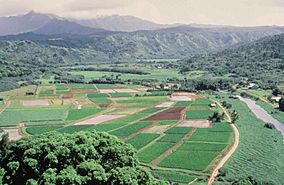Hanalei National Wildlife Refuge facts for kids
Quick facts for kids Hanalei National Wildlife Refuge |
|
|---|---|
|
IUCN Category IV (Habitat/Species Management Area)
|
|
 |
|
| Location | Kauaʻi, Hawaiʻi, United States |
| Nearest city | Princeville, Hawaii |
| Area | 917 acres (3.71 km2) |
| Established | 1972 |
| Governing body | U.S. Fish and Wildlife Service |
| Website | Hanalei National Wildlife Refuge |
The Hanalei National Wildlife Refuge is a special place in Hawaiʻi, found on the beautiful island of Kauaʻi. It's like a safe home for many plants and animals, especially those that are endangered (meaning they are at risk of disappearing forever). This refuge was created on November 30, 1972, to protect amazing Hawaiian birds like the Hawaiian stilt, Hawaiian coot, Hawaiian gallinule, and Hawaiian duck. You can find it in the Hanalei River Valley, right on the northern coast of the island.
Contents
Exploring the Hanalei Refuge's Geography
The Hanalei National Wildlife Refuge is a mostly flat river valley. It sits about 20 to 40 ft (6.1 to 12.2 m) above the ocean. Tall, tree-covered hills surround the valley, reaching up to 1,000 ft (300 m) high.
Climate and Water Flow
The weather here is usually warm, with an average temperature of about 73 °F (23 °C) all year. It also gets a lot of rain, often more than 75 in (190 cm) each year. Water from the Hanalei River is very important for the refuge. It is moved into special ditches to water about 186 acres (75 ha) of taro plants. Taro is a root vegetable grown in Hawaii. The water also fills about 84 acres (34 ha) of special ponds called wildlife impoundments, which are like small lakes for the birds. After this, the water flows back into the river. The entire refuge covers about 917 acres (371 ha).
Amazing Wildlife of the Refuge
The Hanalei National Wildlife Refuge is a critical home for many birds, especially five kinds of endangered Hawaiian waterbirds. These birds are very special because they are found only in Hawaii.
Endangered Hawaiian Waterbirds
- The āeʻo (Hawaiian stilt, Himantopus mexicanus knudseni) is a tall, slender bird with long legs.
- The ʻalae kea (Hawaiian coot, Fulica alai) is a dark bird with a white shield on its forehead.
- The ʻalae ʻula (Hawaiian moorhen, Gallinula chloropus sandvicensis) is a dark bird with a red shield.
- The koloa maoli (Hawaiian duck, Anas wyvilliana) is a type of duck native to Hawaii.
- The nēnē (Hawaiian goose, Branta sandvicensis) is the official state bird of Hawaii.
Besides these special birds, the refuge is also home to 18 other kinds of birds that were brought to Hawaii from other places.
Visiting the Hanalei National Wildlife Refuge
To protect the endangered waterbirds and the important taro crops, most of the wetland areas in the refuge are closed to visitors. However, there are still ways to experience this beautiful area.
Public Access and Overlooks
You can drive along a county road that runs near the river. There are special signs called interpretive panels at the Hanalei Valley overlook. This spot is across from the Princeville Shopping Center. These panels help you learn more about the refuge and its wildlife. There are also plans to build a new overlook and visitor center near the existing one, which will make it even easier for people to learn and enjoy the views.
Historic Rice Mill
Inside the Hanalei National Wildlife Refuge, you'll find the Hoʻopulapula Haraguchi Rice Mill. This mill is a historic site and is listed on the National Register of Historic Places. A special group works here to teach local school kids and visitors about the history and environment of the area. They do this through educational activities and tours.


